 All About Turkey Vulture's! Our Turkey vultures (Cathartes aura, meaning "cleansing breeze") should be considered the official bird of Sonoma County. "Yuck", you might think. Well, let's reconsider the turkey vulture.
All About Turkey Vulture's! Our Turkey vultures (Cathartes aura, meaning "cleansing breeze") should be considered the official bird of Sonoma County. "Yuck", you might think. Well, let's reconsider the turkey vulture.
 All About Turkey Vulture's! Our Turkey vultures (Cathartes aura, meaning "cleansing breeze") should be considered the official bird of Sonoma County. "Yuck", you might think. Well, let's reconsider the turkey vulture.
All About Turkey Vulture's! Our Turkey vultures (Cathartes aura, meaning "cleansing breeze") should be considered the official bird of Sonoma County. "Yuck", you might think. Well, let's reconsider the turkey vulture.
Easily overlooked, or worse, maligned, turkey vultures are a remarkable bird occupying all habitats in our diverse County. They are an elegant and adaptable bird and grace our skies year round. They are abundant and omnipresent. Unless you are out on a very cold morning, you are apt to see at least one, and more likely several birds flying over the Santa Rosa plain.
The Turkey Vulture's head, like its namesake, is bald and red. Its plumage is primarily dark brown. In flight, the undersides of the flight feathers appear silver or white. Genders appear identical. 25 to 32 inches long, with a wingspan around 6 feet, healthy adult Turkey Vultures weigh approximately 6 pounds.
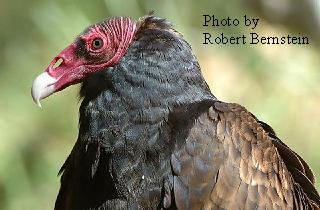 The Vulture's Bald Head: There is an important purpose to the design of the vulture's bald head. When the vulture is eating carrion, it must often stick its head inside the carcass to reach the meat. A feathery head would capture unwanted pieces of the vulture's meal, along with all the bacteria it hosts. After mealtime, the turkey vulture perches in the heat of the sun. Then, whatever has managed to cling to the few bits of fuzz on their head will be baked off once and for all.
The Vulture's Bald Head: There is an important purpose to the design of the vulture's bald head. When the vulture is eating carrion, it must often stick its head inside the carcass to reach the meat. A feathery head would capture unwanted pieces of the vulture's meal, along with all the bacteria it hosts. After mealtime, the turkey vulture perches in the heat of the sun. Then, whatever has managed to cling to the few bits of fuzz on their head will be baked off once and for all.
Turkey vultures, like most other vultures, have very few vocalization capabilities. They can only utter hisses and grunts. They usually hiss when they feel threatened. Grunts are commonly heard from their hungry young, and adults in courtship.
Diet/Feeding: The Turkey Vulture, contrary to popular belief, does not feed strictly on carrion. This bird enjoys plant matter as well, including shoreline vegetation, pumpkin, and bits of other crops. The Turkey Vulture soars above the ground for most of the day, searching for food with its excellent eyesight and highly developed sense of smell. Extremely non-aggressive and non-confrontational, the Turkey vulture will not feed on live prey, an occasional habit of its cousin the black vulture. Turkey Vultures can often be seen along roadsides, cleaning up road kill, or near rivers, feasting on washed-up fish, another of their favorite foods. Cooperatively, you may see an entire group remain aloft until sufficient birds have arrived to dispose of a carcass in a timely fashion.
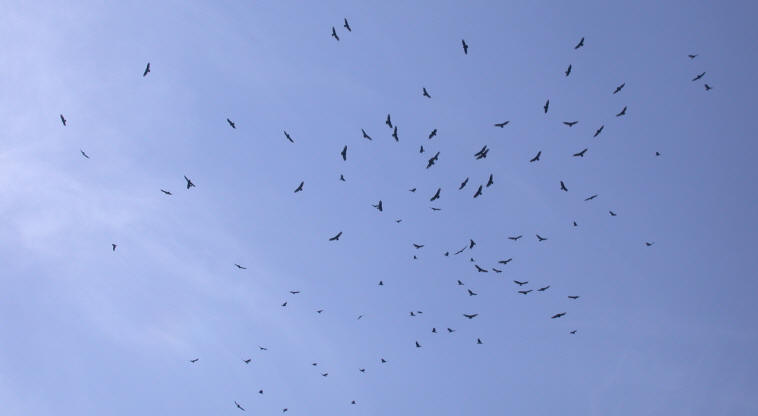 How the Turkey Vulture Flies: Turkey Vultures fly with their wings in a dihedral (V-shape. Turkey vultures gracefully soar for hours at a time on rising air currents, rarely flapping their wings. These large, shy birds with a five and a half foot wingspan are built for soaring. (Their flight appears unsteady at times, almost as if they are trying not to flip over). This dependence on soaring allows them to travel great distances with little energy expenditure. TVs are known to cover 40 miles in a day.
How the Turkey Vulture Flies: Turkey Vultures fly with their wings in a dihedral (V-shape. Turkey vultures gracefully soar for hours at a time on rising air currents, rarely flapping their wings. These large, shy birds with a five and a half foot wingspan are built for soaring. (Their flight appears unsteady at times, almost as if they are trying not to flip over). This dependence on soaring allows them to travel great distances with little energy expenditure. TVs are known to cover 40 miles in a day.
Their occasional necessary flaps and takeoffs are quite laborious, however, and the birds often fall victim to predators and cars as a result.
Children love to pretend they are Turkey Vultures — have them fly in a kettle!
 The turkey vulture is one of the most skilled gliders among the North American birds. It migrates across the continents with minimal energy output. Vultures launch themselves from their perches only after the morning air has warmed. Then, they circle upward, searching for pockets of rising warm air, or thermals. Once they have secured a thermal, they allow it to carry them upward in rising circles. When they reach the top of the thermal, they dive across the sky at speeds near 60 miles per hour, losing altitude until they reach another thermal. All this is done without the necessity to flap. In fact, the turkey vulture can glide for over 6 hours at a time without flapping a wing! They also rely on thermals of warm air to remain aloft while scanning the ground for food.
The turkey vulture is one of the most skilled gliders among the North American birds. It migrates across the continents with minimal energy output. Vultures launch themselves from their perches only after the morning air has warmed. Then, they circle upward, searching for pockets of rising warm air, or thermals. Once they have secured a thermal, they allow it to carry them upward in rising circles. When they reach the top of the thermal, they dive across the sky at speeds near 60 miles per hour, losing altitude until they reach another thermal. All this is done without the necessity to flap. In fact, the turkey vulture can glide for over 6 hours at a time without flapping a wing! They also rely on thermals of warm air to remain aloft while scanning the ground for food.
Contrary to popular belief, circling vultures do not necessarily indicate the presence of a dead animal. Circling vultures may be gaining altitude for long flights, searching for food, or playing.
 Range/Habitat: By far the most widespread of the New World vultures, the Turkey Vulture can be found throughout the entire United States, north into Canada along the east and west coasts, and south into central South America. These birds prefer open areas, but can be found almost anywhere. They live along coastlines; in deserts; throughout plains; and even in inland forests.
Range/Habitat: By far the most widespread of the New World vultures, the Turkey Vulture can be found throughout the entire United States, north into Canada along the east and west coasts, and south into central South America. These birds prefer open areas, but can be found almost anywhere. They live along coastlines; in deserts; throughout plains; and even in inland forests.
Behaviors: The Turkey Vulture is gentle and non-aggressive. Turkey Vultures roost in large community groups, breaking away to forage independently during the day. These unique birds have a variety of interesting habits.
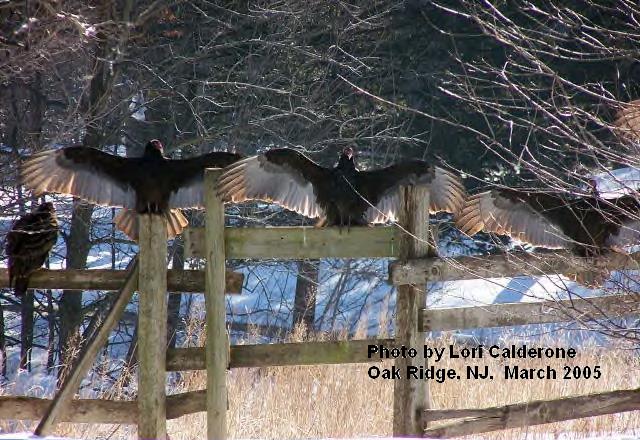 The Horaltic Pose: Turkey Vultures are often seen standing in a spread-winged stance. This is called the "horaltic pose." The stance is believed to serve multiple functions: Drying the wings, warming the body, and baking off bacteria.
The Horaltic Pose: Turkey Vultures are often seen standing in a spread-winged stance. This is called the "horaltic pose." The stance is believed to serve multiple functions: Drying the wings, warming the body, and baking off bacteria.
Why the Turkey Vulture Vomits: The turkey vulture has few natural predators. Its primary form of defense is vomiting. The birds do not "projectile vomit," as many would claim. They simply cough up a lump of semi-digested meat. This foul smelling substance deters most creatures from raiding a vulture nest. The substance will also sting if the offending animal is close enough to get the vomit in its face or eyes. In some cases, the vulture must rid its crop of a heavy, undigested meal in order to lift off and flee from a potential predator. In this case, the regurgitated material has not yet been digested. Most predators will give up pursuit of the vulture in favor of this free edible offering. Tempting, eh?
Why the Turkey Vulture Urinates on its Legs: The turkey vulture often directs its urine right onto its legs. This serves two very important purposes. In the summertime, wetting the legs cools the vulture, as the urine evaporates. (The vulture cannot sweat like us). In addition, this urine contains strong acids from the vulture's digestive system, which kill any bacteria that may remain on the bird's legs from stepping in its meal.
 Breeding/Life Cycle: The turkey vulture nests on the ground and in caves, inside hollow tree cavities low to the ground. It does not construct a traditional "nest," but rather scratches out an indentation in the soil. Vulture nests are often found in abandoned barns and sheds, which provide safe hiding places similar to a cave or a hollowed log. They can raise only one brood a year, consisting of 1 to 3 (but usually 2) blotchy-looking eggs. Both parents share the responsibilities of incubating and caring for the brood. The eggs incubate for 38 to 41 days. Both parents share the responsibilities of incubation
Breeding/Life Cycle: The turkey vulture nests on the ground and in caves, inside hollow tree cavities low to the ground. It does not construct a traditional "nest," but rather scratches out an indentation in the soil. Vulture nests are often found in abandoned barns and sheds, which provide safe hiding places similar to a cave or a hollowed log. They can raise only one brood a year, consisting of 1 to 3 (but usually 2) blotchy-looking eggs. Both parents share the responsibilities of incubating and caring for the brood. The eggs incubate for 38 to 41 days. Both parents share the responsibilities of incubation
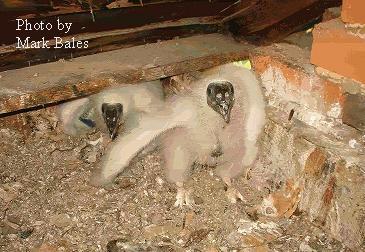 Young are covered in pure white down, and have dark grey faces.
Young are covered in pure white down, and have dark grey faces.
Young fledge 70 to 80 days after hatching. Immature fledglings still have darker heads, and can be confused with the black vulture, from a distance.
This bird is protected by international Migratory Bird treaties, and its numbers are healthy. It is estimated that turkey vulture populations have grown by 1.79% in recent years.
Turkey Vulture juveniles (over one year) have a dark downy coating on their head, which disappears as they mature. They do not typically display the white facial spots of adults.
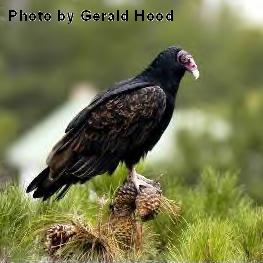 The Turkey Vultures Sense of Smell: The turkey vulture was originally thought to be one of the only birds in North America with a sense of smell. Recent studies are beginning to show that many bird species use smell for a variety of things such as navigation, finding food, identifying a mate, and avoiding things with smells that are repulsive. But the Turkey vulture relies both on its keen eyesight and powerful nose to search out food.
The Turkey Vultures Sense of Smell: The turkey vulture was originally thought to be one of the only birds in North America with a sense of smell. Recent studies are beginning to show that many bird species use smell for a variety of things such as navigation, finding food, identifying a mate, and avoiding things with smells that are repulsive. But the Turkey vulture relies both on its keen eyesight and powerful nose to search out food.